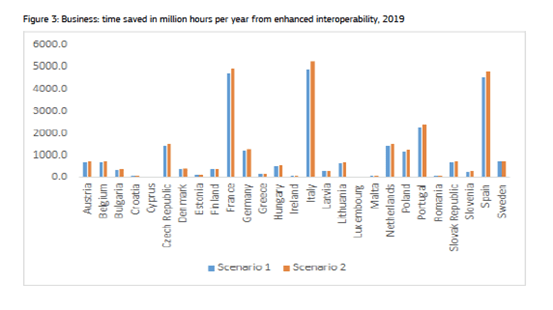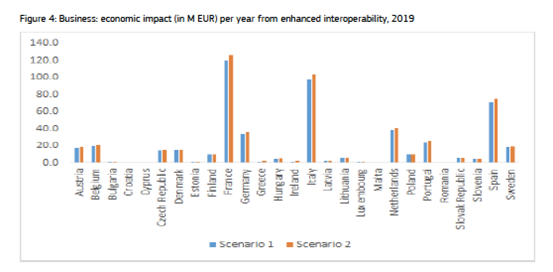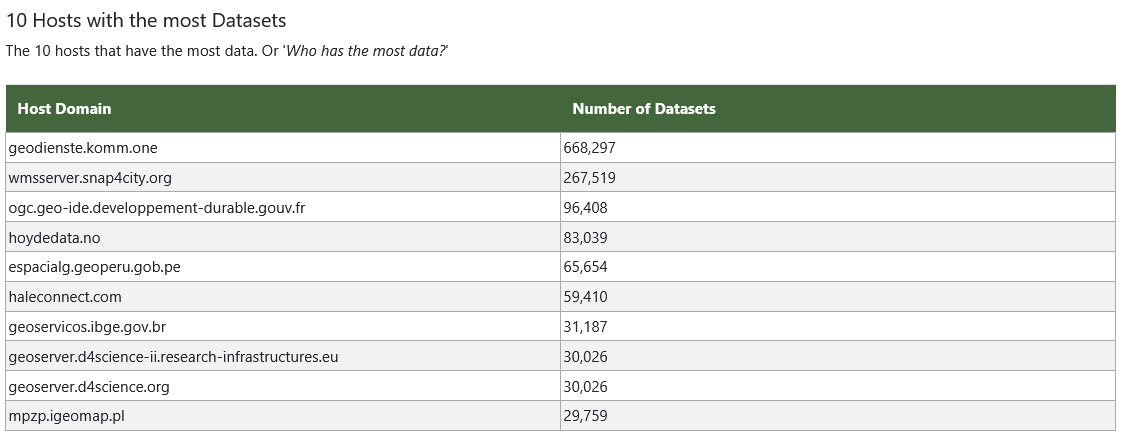
Making Interoperable Data Count
Have you ever wondered how much money the government wastes due to lack of interoperability?
The European Commission's Joint Research Centre (JRC) new report answers exactly that question. The answer is in the ballpark of 500 billion EUR.
The recently released report shows that even a minor gain will have significant impact on the bottom line for data providers, citizens, and businesses. Here's how.
Please note that this is only a summary of some of the key findings in the report. To understand the methodology of data collection and data analysis in-depth, please access the report here.
The Data Providers’ Return on Investment
The actual benefits of the time and effort involved in improving data interoperability can seem ambiguous. These benefits are made clearer by framing them in the context of their impact on the E-Government Development Index (EGDI).
The EGDI measures 3 dimensions:
- Provision of online services
- Telecommunications
- Human capacity
Interoperability streamlines the exchange of information between different parties, and the efficiencies gained positively impact each of these three dimensions. For example, more interoperable systems can boost the information exchange between different devices (this is especially critical given the rise of 5G and IoT). Or, from the online service perspective, increase citizen participation in decision-making processes such as where to set up schools by providing more efficient platforms for exchanging information.
According to the report, a mere 1% increase in the EGDI leads to an impact on the following metrics:
Gross Domestic Product (GDP):
A measurement that seeks to capture a country's economic output.
The report suggested an improvement of 0.4% in GDP.
Government revenues:
Refers to the total amount of revenues collected in a year.
The report predicted an improvement equal to 0.07% of the GDP.
Policy performance:
Refers to the development of social, economic and environment conditions for the wellbeing of citizens.
The report predicted an improvement equal to 0.3% of the GDP.
Government production costs:
Costs including employee compensation, government usage of goods and services, depreciation, etc.
The report predicted an improvement equal to 0.3% of the GDP.
General government spending:
Measured in terms of a percentage of GDP, this refers to the expenditure on delivering public goods and services such as social protection.
The report predicted an improvement equal to 0.6% of the GDP.
Government effectiveness:
Refers to the inputs required for the government to be able to produce and implement policies and deliver goods.
The report predicted an improvement equal to 0.2% of the GDP.
For those who love statistics, here’s a table of the regression analysis:

The Citizens’ Benefits
Intuitively, saying that more efficient government processes benefit a country’s citizens makes sense. Now, the JRC’s research has quantified that benefit.
Interoperability improves public online services and reduces the bureaucratic load, which not only makes the processes more efficient for citizens who already use public services, but also motivates those who currently don’t currently use them.
According to the JRC, this can lead to 21-24 million hours saved per year across the EU27. Assuming average hourly wages as a basis, this is equivalent to approx. 473m to 543m EUR per year.
The impact per country can be seen below.

The Businesses’ Benefits
While the costs of setting up a business can vary greatly across the EU, doing so more efficiently will always make life easier.
A large range of online services is already available to business providers, from registering property to declaring taxes.
As with the citizens, the JRC assumes both a reduction in time spent by those who already use these processes (Scenario 1) and an uptick in the overall use of digital processes as they become more efficient (Scenario 2).
Currently, businesses across the EU27 spend 172 billion hours per year on setting up businesses. That’s around 250,000 lifetimes!
Increased data interoperability would save approximately 27.6 billion hours and 30 billion hours for scenario 1 and 2, respectively. That equates to 521bn EUR for scenario 1 and 561bn EUR for scenario 2. In each case, that’s more than the nominal GDP of Austria in 2021.
The impact per country can be seen below.


How do we get there?
The study clearly demonstrates the potential benefits of even a minor improvement in terms of data interoperability. The question that remains is how we can achieve that.
The EU has taken a long-term view on reaping the benefits of interoperability and making data more useful.
Interoperability and accessibility initiatives (such as INSPIRE) have allowed us to take crucial steps towards greater data interoperability. Tools such as hale»connect and hale»studio have streamlined the implementation of these standards into a partially automated process. We've seen hundreds of thousands of INSPIRE compliant datasets published with our tools - as a matter of fact, hale»connect and hale»studio have even set a world record for number of datasets published, as shown below (Komm.One is a hale»connect based data provider):

However, the impact of open data standards is merely the tip of the iceberg.
Going beyond data standards, the EU data strategy continues to emphasise the importance of more accessible and more useful data. It sets clear rules on the access and reuse of data and invests in the next generation of tools that store and process data.
Data spaces are the most important part of this new generation of data initiatives. By providing granular control over what is and is not shared between certain parties, data spaces comply with the governance rules dictated by the EU data strategy. This means that previously inaccessible data (for example, exact locations of endangered species or medical data) can be utilised to a greater extent without sacrificing data sovereignity, resulting in a much larger pool of data to draw from.
wetransform is determined to ensure that this larger data pool is not only available, but is also fully interoperable. Our product lines are being extended to support the creation and maintenance of data spaces. Drawing from our expertise in the implementation of open data standards, we are now deeply involved in the creation of the Environmental Data Space. You can learn more about the environmental data space community and get involved here.
Conclusion
Improved efficiency makes government processes take less time, which comes with very real benefits to data providers, businesses, and citizens.
While some of the study’s numbers are hypothetical, the scenarios presented accurately resemble real world conditions and a 1% improvement of the EGDI is attainable.
The potential impact on the bottom lines for data providers and businesses, as well as the benefit in terms of time spent for a nation’s citizens and government officials are also realistic predictions.
A fairly straightforward way to improve the efficiency of government processes is by improving the interoperability of data, which streamlines the flow of information between parties.
The best way to make data sets interoperable is by using ETL and publication tools, such as hale»studio and hale»connect. To learn more about how these tools aid in increasing the interoperability of data, check out our hale»studio and hale»connect pages!
A big thanks to Peter Ulrich, Nestor Duch Brown, Alexander Kotsev, Marco Minghini, Lorena Hernandez Quiros, Raymond Bogulawski, and Francesco Pignatelli for pulling this report together.



